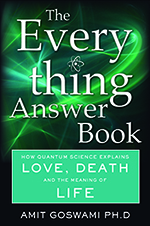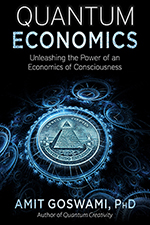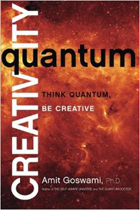Should Deepak Chopra be Hassled for Claiming Reality is Formless
By Amit Goswami
Several days ago, I was at a conference call with my students in a distance education course called Science and Spirituality when a student brought up some headline news he’d read about the famous Deepak Chopra and his grilling by a group of scientists on the Internet. I had an idea where on the Internet this might be occurring. For months, I have been at the receiving end of a forum set up to critique a Bhaktivendanta Institute biologist’s paper on a Vedic theory of evolution that was published in a biology journal. Occasionally, I do look at the back and forth. Sometimes it is good. Other times, the arguments are a little silly, but scientists are human after all. Nonetheless, I have been traveling lately and have not been consistent in following the discussion.
So I went back to the postings, and indeed there was a raging discussion going on about Deepak’s depiction of reality as “formless.” In particular, there seemed to be lots of anguish about the idea that form can arise from the formless.
Now this depiction does not originate with Deepak, and Deepak never claimed it did. This depiction is common in the esoteric school of most spiritual traditions. Why is reality formless? The ancient scientists of consciousness saw consciousness, or reality, as all-inclusive. Form, you know, is specific. If reality has to be all-inclusive, then it cannot have a particular specific form, they intuited. That’s why they called an inclusive reality formless, transcending all form.
How does form arise from formlessness? The theoreticians from India, no doubt based on creative experiences, theorized that a force or mechanism called “Maya” creates the appearance of form, which also brings on an appearance of separateness whereas the formless is an inseparable “whole.”
Another way to think of reality was given by Buddhism. An all-inclusive reality can also be conceived as “Nothingness,” or the great Void: Void of forms. The subject-object split reality that we call awareness arises from this spontaneously via “dependent co-arising,” say the Buddhists.
We can be sympathetic to this. If reality has to be inclusive of all experiences, some external, some internal, there is another angle to look at all this. Our externally experienced reality is the material reality, which is reductionist; macro can be reduced to the micro, eventually to the elementary particles. But similar reduction of the internal experiences does not meet with success. For example, even Descartes acknowledged that the mind is a boundless ocean, one thing. There can be waves in that ocean, our thoughts; but breaking down the waves into simpler forms does not help. Thus, a reality that includes both external and internal better be a whole inclusive of both wholes and reducible things like matter.
Now modern day scientists, most of them subscribing to the philosophy of scientific materialism (the bulk of Deepak’s critics), don’t look kindly at all this since they assume that only the reductionist matter is real and all else is epiphenomenon of matter. They say that positing nonphysical objects would be tantamount to dualism and then the question of how the nonphysical interacts with the physical would haunt us. And if we agree that the internal, mind, etc., are nothing but matter, then do we really need to posit that reality itself is anything but?
Unfortunately, there are a couple of impossible problems that go with this: One is life, and one is that conscious beings like us who have subject-object experiences where the question of subjective qualia—the felt quality of an experience —just cannot be denied. It makes sense that there must be “irreducible wholes” even in matter like the living cell and the brain, irreducible wholes that are to make a representation of the irreducible reality that is the transcendent ground of being.
We have an impasse. The formless reality idea cannot explain how form or separateness arises except with vague words; materialists cannot explain life or conscious awareness that we humans experience.
The funny thing is this. I have solved these problems long ago based on quantum physics, although the entirety of the solution did not come in one fell swoop. Still, shouldn’t consciousness researchers read other people’s research?
Anyway, laments aside, the part that really surprises me is this. Quantum physics is the latest uncannily accurate theory of physics; everybody agrees with that. And even the basic concept of quantum physics called wave-particle duality unequivocally teaches us that there are two domains of reality: The domain of potentiality where nonlocality (signal less communication) reigns and the manifest domain of reality of experiences of which the space-time reality where matter moves is a subset.
Examine the words: Domain of potentiality or possibility. Here objects are waves of possibility. This then is the answer to the question, what is formlessness? Potentiality or waves of possibility precedes form. Nonlocality suggests an instant interconnectedness. When we work out the details we find that this nonlocal interconnectedness is our consciousness in the original, and we come with this complete statement of quantum metaphysics: Consciousness is the ground of all being, and all objects are possibilities of consciousness itself to choose from. In this way, the ground of being, consciousness, is formless. It is also wholeness, an irreducible whole connected by nonlocality. Got it? And nonlocality is an experimentally verified idea; don’t fight it.
Notice the Hindu description is compatible with the Buddhist description also. We can say reality is full of potentiality; we can also say reality is empty of manifest form. Take your pick.
How does form come about from formlessness? Via conscious choice the waves of possibility become objects of actuality; in the process consciousness identifies with the observer’s brain. And for this to happen, for making a representation of irreducible consciousness (the self) the brain (and the living cell) has to be an irreducible whole as well. The brain is that by virtue of having a tangled hierarchy of its perception system and its memory system; these two systems, on the way of micro to macro operate on each other tangled hierarchically. For the living cell you can see tangled hierarchy in the way the two macromolecules DNA and protein operate on each other in the functioning of the cell.
Okay, you can read any one of my books (for example, Creative Evolution) to understand tangled hierarchy better. You can also appreciate why the manifestation of form from formlessness can be called an appearance, a secondary reality. But that is not really a serious point. There is order in the manifest; we must take the manifest seriously as opposed to what the ancients did.
The relevant point I want to make here is that: (1) Deepak is right, which means that the ancient philosopher seers were right, no need to give Deepak a hard time. And (2) Modern science in the form of quantum physics not only enables us to understand the ancient philosopher/scientists but also further clarifies and extends their work as in materialist science today. In science, we always expand on earlier work and consciousness science is no exception. But the explorers need to read each other’s work. Then progress will be faster.



